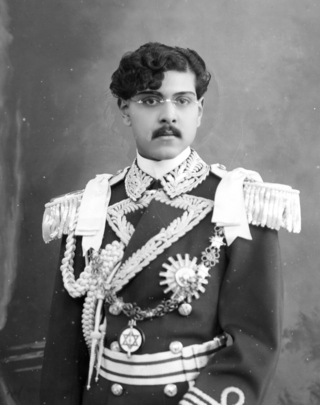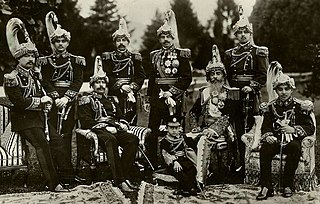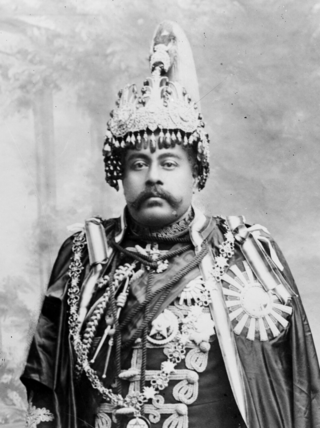
Tribhuvan Bir Bikram Shah, was the eighth King of Nepal. Born in Kathmandu, the capital city of Nepal, he ascended to the throne at the age of five, upon the death of his father, Prithvi Bir Bikram Shah, and was crowned on 20 February 1913 at the Nasal Chowk, Hanuman Dhoka Palace in Kathmandu, with his mother acting as regent. At the time of his crowning, the position of monarch was largely ceremonial, with the real governing power residing with the Rana family.
Princess Shruti Rajya Lakshmi Devi Shah of Nepal was the daughter of King Birendra and Queen Aishwarya, and sister of King Dipendra and Prince Nirajan.

Durbar High School or Bhanu Higher Secondary School, opened in 1854 is the oldest English education school which publicly established English education system in the country. in Nepal located near Rani Pokhari,Kathmandu whereas the first school of Nepal is considered Yjnayavalkya Vidyapeeth at Matihani of Mahottari. The school was originally built to teach sons of Ranas exclusively but was opened to public citizens in 1902 by Dev Shumsher Jang Bahadur Rana. At first, Rana children were given education at Thapathali Durbar but later Jung Bahadur Rana moved it into its own building at Ranipokhari, Kathmandu.

The Rana dynasty were a Chhetri dynasty that imposed authoritarianism in the Kingdom of Nepal from 1846 until 1951, reducing the Shah monarch to a figurehead and making the Prime Minister and other government positions held by the Ranas hereditary. They are Kshatriya, whose ancestors were descended from the Ranas of Udaipur, Rajasthan, India. The Rana dynasty is historically known for their iron-fisted rule. This changed after the Revolution of 1951 with the promulgation of a new constitution, when power shifted back to the monarchy of King Tribhuvan.

Subarna Shamsher Rana was a leading figure in the movement to overthrow the ruling Rana oligarchy and to establish democracy in Nepal. He was one of the three leaders of the Nepali Congress in the late 1940s, opposing his relatives, the Rana family, who held power in Nepal at the time.

Nepal Student Union is the largest student political wings in Nepal. The Nepal Student Union represents the Nepali Congress. During the autocratic King's rule, the union played a major role in unifying students to overthrow King's direct rule and establish democracy in the country.

Tri-Chandra Multiple Campus is a constituent campus of Tribhuvan University located in Ghantaghar, Kathmandu. Found in 1918 by Chandra Shumsher, it is the oldest institute of higher learning in Nepal.

Field Marshal Shri Shri Shri Maharaja Sir Juddha Shumsher Jung Bahadur Rana was the Prime Minister of Nepal from 1 September 1932 to 29 November 1945 as the head of the Rana dynasty.
The Biratnagar Jute Mill Strike of March 1947 was a labor strike in Biratnagar, Nepal, by workers and laborers of Biratnagar Jute Mill, Ltd. The strike was initially part of a dispute between mill workers and management regarding labor rights, but gradually the strike grew into a nationwide anti-regime movement.

The revolution of 1951 in Nepal, also referred to as Sat Salko Kranti, was a political movement against the direct rule by the Rana dynasty of Nepal which had lasted for 104 years. It marks the beginning of the political awakening and democratic movements in Nepal, and resulted in immediate abolition of the institutionalized hereditary Prime Minister system in Nepal.

Babar Mahal, Baber Mahal is a Rana palace in Kathmandu, the capital of Nepal. The palace complex, located north of the Bagmati river, was incorporated in an impressive and vast array of courtyards, gardens and buildings. Initially, the palace was under Jung Bahadur Rana's Thapathali Durbar but was later separated, demolished and rebuilt by Chandra Shumsher Jang Bahadur Rana, as prime minister and the executive leader of Nepal.

Kaiser Mahal is a Rana palace in Kathmandu, the capital of Nepal. The palace complex, located west of the Narayanhity Palace, was incorporated in an impressive and vast array of courtyards, gardens and buildings.

Pashupati Shumsher Jung Bahadur Rana is a politician from the Rana dynasty. He served in the Ministry of Foreign Affairs, the Ministry of Finance, the Ministry of Water Resources and Communication (1990–1994), Minister of Water Resources after the Panchayat era. He served as Minister of Panchayat and Local Development (1986–1988), Ministry of Transport and Tourism (1978–1979) and various other full ministers and state ministers during the Panchayat era. He is also one of the richest people in Nepal.

Dhir Shumsher Kunwar after 1848 known as Dhir Shumsher Kunwar Ranaji or Dhir Shumsher Jang Kunwar Ranaji or shortly Dhir Shumsher Rana posthumously known as Dhir Shumsher Jang Bahadur Rana was a Nepalese politician, army general, and minister of state. He served as the Commander-In-Chief of the Nepalese Army from 1879 to 1884.
Krishna Bahadur Kunwar after 1848 CE known as, Krishna Bahadur Kunwar Rana was the Nepalese politician, administrator, military general and minister of state. He served as the acting Prime Minister of Nepal upon the demise of his elder brother Bam Bahadur Kunwar from 25 May 1857 to 28 June 1857. He also served as the Commander-In-Chief of the Nepalese Army between 1857 and 1862.
Makaiko Kheti is a 1920 lost literary work by Krishna Lal Adhikari. Adhikari had been inspired to write a book about maize cultivation after reading an Indian book that a friend had given him. With permission from Nepali Bhasha Prakashini Samiti, the book was released in July 1920, with 1,000 copies being printed. Detractors accused the book of containing double entendres which purportedly attacked the Rana dynasty that had ruled over the Kingdom of Nepal since 1846. Adhikari was sentenced to nine years in prison where he died.

Shambhu Prasad Dhungel was a Nepali author, playwright, and poet.

Lieutenant-General Sir Bahadur Shumsher Jung Bahadur Rana C.B.E GCSI was a Nepalese diplomat. He was the first Nepalese Ambassador to the United Kingdom.

Ripu Malla was the Maharajadhiraja of the Khasa Kingdom who reigned in the early 14th century. He is best remembered for being the last visitor to Lumbini, the birthplace of the Gautama Buddha that left an inscription of his visit.
Lamjung and Kaski was a state which was given to His Highness Shree Tin Maharaja Jung Bahadur Rana in 1856 by His Majesty King Surendra Bir Bikram Shah.















